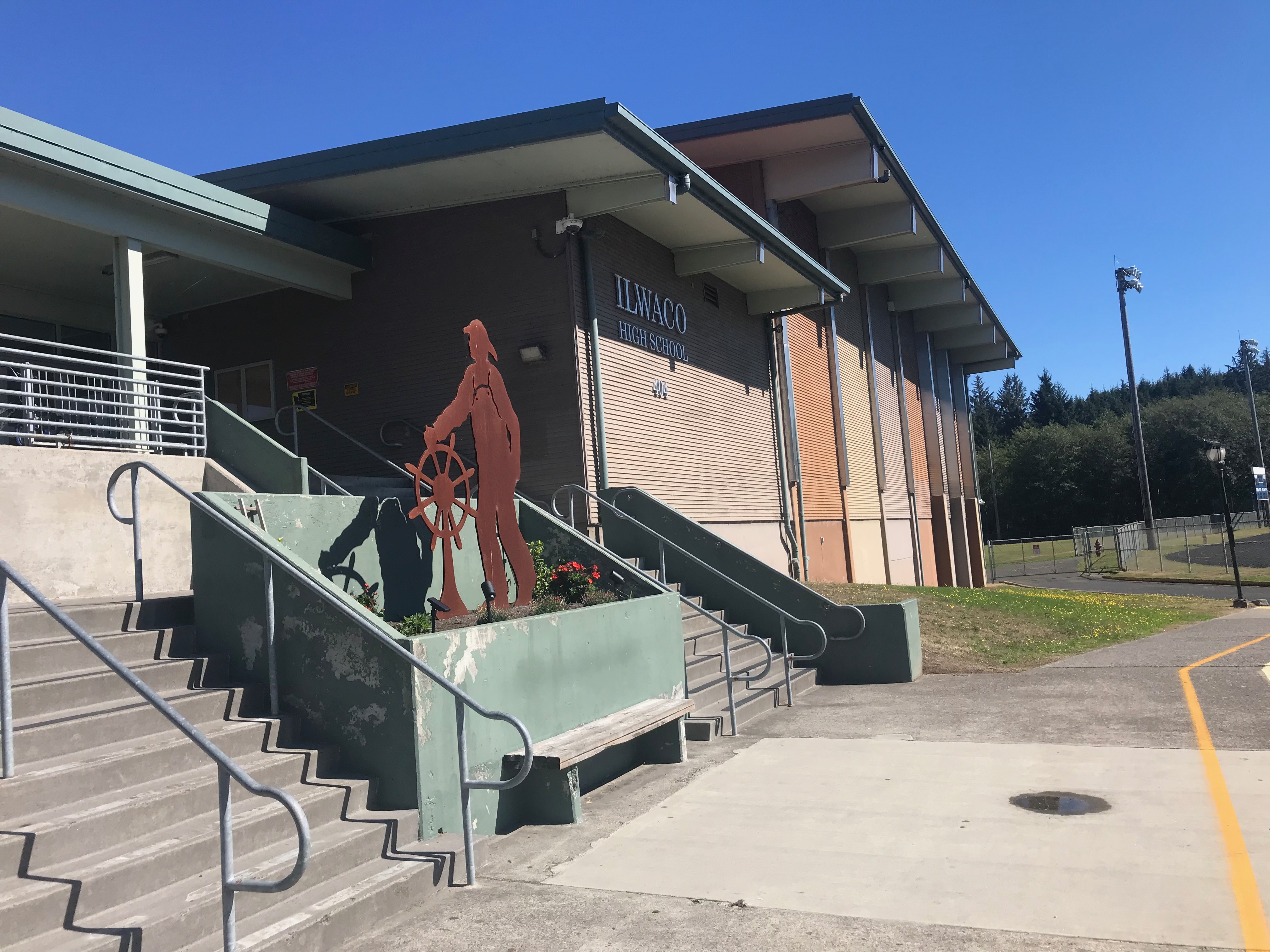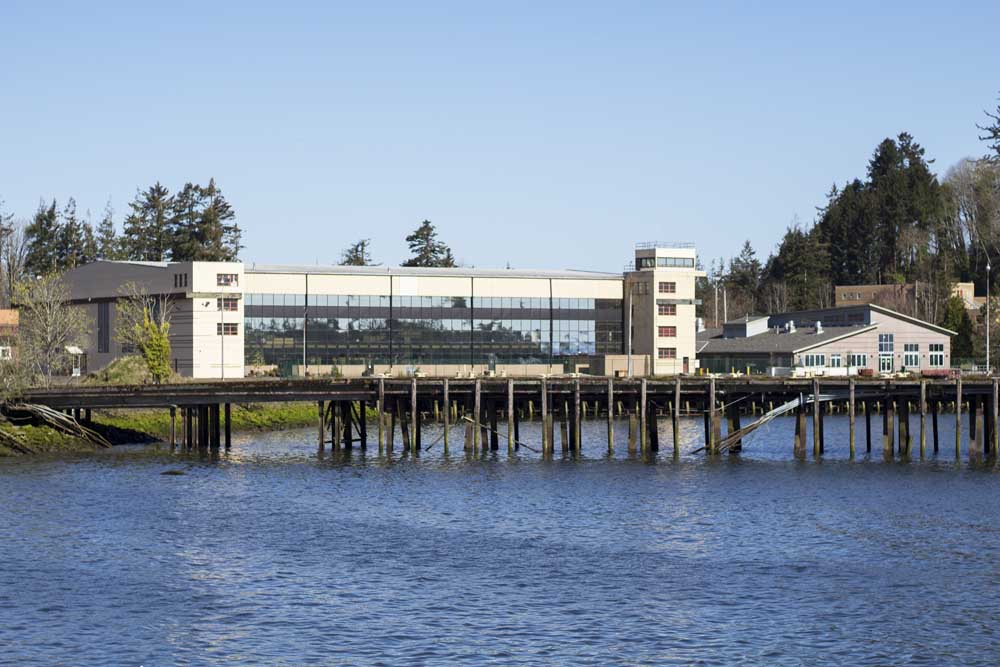Chapter Five: Chinese and Ethnic Cannery Workers
Published 5:00 pm Tuesday, May 29, 2007

- An etching shows working conditions in the Kinney Cannery, which became part of CRPA in 1899.
EDITOR’S NOTE: Irene Martin, the foremost historian of the Columbia River fishing industry, has written a series of articles about the Columbia River Packers Association.
The CRPA was the product of a historic merger of several of the Columbia’s major salmon canners in 1899. It dominated the industry for most of the 20th century, employing thousands of individuals on both sides of the river, in Alaska and elsewhere. Eventually changing its name to Bumble Bee Seafoods, CRPA is a fascinating story of capitalism, adventure and social change.
Eventually to be gathered in a book, this series represents years of effort undertaken at the behest of Bumble Bee retirees. Originally started by historian Roger Tetlow, who before his death in 1999 lived on the Peninsula and in Hammond, Ore., the CRPA project was taken up by the Chinook Observer as part of its commitment to preserving and telling local history.
We are proud to publish this series. We will soon begin soliciting pre-sales for the richly illustrated book that we anticipate publishing in about one year.
As canneries proliferated along the Columbia River, the difficulties in recruiting enough laborers to process the product became acute. William Hume had advertised in the Oregonian in 1869 for labor for his cannery, seeking “twenty young men and boys to work at canning fish at Hume and Co.’s packing establishment.” By the 1870s local labor could not meet the demand. Folklore has it that at the suggestion of his Chinese cook, George Hume was the first to employ Chinese labor at his cannery at Eagle Cliff, Wahkiakum County, in 1870.
Whether this tale is true or not, Wahkiakum County seems to have attracted the first influx of Chinese laborers, according to the census of 1870. Clatsop, Pacific and Columbia counties along the Columbia followed suit. By 1880 the census reports show that “Astoria alone had 1,667 Chinese employed in the canneries. … Between 1870 and 1880 in the four counties bordering the lower Columbia River, the Chinese population went from 34 to 3,090.” By 1880 more than 77 percent of the Chinese were employed in the canneries. Other occupations included cook, laundry worker, gardener, and, on the Long Beach Peninsula, cranberry harvester.
The system of recruitment depended upon a Chinese labor contractor, who signed a contract with the cannery owner at the beginning of each season to furnish a certain number of laborers at a fixed price. The labor contractor had a position of power within the packing industry. George Cornwall, editor of the Cathlamet Gazette, a newspaper that began in 1889, prided himself on his up-to-date statistics of the salmon pack, “gleaned by favors and flattery from the boss Chinamen of the numerous canneries that dotted the shores of the mighty river. These figures were trade secrets jealously guarded by individual packers, but nevertheless they appeared at regular intervals. Prices in New York were often made on the strength of these forecasts and performance records furnished by the little Cathlamet Gazette.” The “China Boss,” as the contractor was often called, was the intermediary between the crew and the packer or cannery owner, and his role had many facets.
The contractor recruited workers in China, loaning them money for their passage to the U.S. and taking care of the paperwork involved in getting labor certificates. The borrowed money was to be paid back by the employee from wages earned at the cannery. Wages in the U.S. were so much higher than those in China that America was referred to as the “Golden Mountain.” Not all contract labor entered the country legitimately. As Duncan Law, a former contract laborer, explained, “They would come in on false papers the Chinese would call “gotchee” which means fake papers. And so they didn’t dare complain, no matter how bad the situation because if they were investigated, it could mean easily a trip back to China without any chance to make any money.”
A typical Chinese contract stipulated the tasks to be performed by the crew and the price. The packers furnished housing and food and sometimes transportation, but deducted the charges from the labor contractor’s fee. At the end of the season, the cannery owner paid the labor contractor, or “China Boss,” who in turn paid his crew and deducted such charges as food. These were the bare essentials of the contract. The details involved establishing the right to garden and raise pigs, the inclusion of a cook in the crew, and the provision of water, fuel and salt. Such details differed from one contract to another. A packer would agree to pack so many cases of salmon at a fixed price per case. If the pack came in over the number agreed upon, the extra cases were paid for at the fixed rate. If it came in under prediction, the packer was obligated to pay the stipulated amount for the contract. Variations on this theme occurred from contractor to contractor and cannery to cannery. For example, CRPA advanced money for the crew of Chu Chew to celebrate Chinese New Year, a sum of $4,000 in 1903, which was considerable for that time.
The contract system was ripe for abuse – by the packers, who felt absolved of the responsibility for looking out for their employees’ welfare, and by the labor contractor, who might skimp on the food but charge exorbitant fees for providing it. Few of the workers learned to speak English, and fewer still to read and write the language. During the off-season when they returned to cities such as Portland and San Francisco, they might be at the mercy of their contractors who operated rooming houses, stores and other facilities. This “company store” arrangement forced them to purchase their necessities from their contractor, in order to retain their jobs. Gambling might prove their undoing, as the contractor might include a professional gambler in the crew in order to fleece them of their wages. A worker injured on the job was considered the responsibility of the contractor, rather than the canner. Such medical issues presented a gray area that was seldom resolved to the worker’s advantage.
Chinese crews excelThe Chinese crews excelled in the canning tasks and were cheaper than other sources of labor. A typical work day lasted 10-11 hours, and the crew worked six days a week. In times of abundant fish, hours might be considerably longer. Contracting with a China Boss simplified the packers’ job and kept the canning lines running smoothly under harsh working conditions of dampness, cold and the constant repetitive motions of fish butchering. And the profits were enormous. According to Duncan Law, who worked in the canneries as a contract laborer, “The contractor was given so much money to deliver so many cans of product. And of course, it wasn’t unusual for the contractor in those days to clear $50,000 or even as much as $75,000 in one season and in those days, without any taxes, that was a lot of money.”
Fish butchers, slimers, graders, and fillers stayed in bunkhouses, four to a room. They brought their own foods and culture with them, as evidenced by remains found on cannery sites. Pottery with distinctive Chinese patterns, game pieces, opium bottles and pipes, and Chinese medicine bottles have all surfaced in archaeological digs. Each cannery had a special kitchen for the Chinese cook. The kitchen had woks built into the top of a brick stove, so that Chinese food could be provided for the crews. There was a Chinese grocery store in Astoria. “They’d carry Chinese dried foods, of course in China without the refrigeration…much of the stuff was dried. So you would get these dried lilly roots and dried bamboo shoots and dried abalone and all those types of things that would not require refrigeration.” Ads for Chinese herbs and medicines and itinerant Chinese doctors appeared in the Astoria newspaper.
The workers were almost entirely male, with few Chinese females present in the lower Columbia region in the 19th century. Most of the men planned to save their money, go back to China and marry. In 1882 the Chinese Exclusion Act was passed, which “provided for the entry of Chinese merchants, but not laborers. … The population, the flow of immigrants from China was cut and the Chinese population dropped markedly because they never wanted to come here to stay anyway; they wanted to make enough money to go back to China to die.”
The racism of the era was also responsible for their desire to return. One cannery label, from the Warrenton Canning Co., asserted that the product was “packed by white labor.” The Astoria Guide, a shipping timetable published Sept. 7, 1889, by Ed Wright contained an ad from Serras Restaurant in Astoria, claiming “No Chinese employed.” An item in the Sept. 8, 1881, issue of the Oregonian pointed out that “Chinamen are used by all the canneries except the original estate of William Hume at Eagle Cliff. Hume sticks to the white men on principle and is able to measure results with anybody.” Some years later, however, he did not hesitate to dismiss his white crew and employ Chinese laborers in order to prevent a strike in his cannery.
In 1903 an alternative to Chinese labor, known as the “Iron Chink,” made its appearance at a cannery in Fairhaven. Invented by Edmund A. Smith, and obviously named for its purpose of replacing Chinese workers, one machine could complete the work of 30 to 40 laborers butchering fish. As the Chinese Exclusion Act had gradually reduced the numbers of Chinese laborers available to canneries, bottlenecks occurred in the canning process. Chief among these was the salmon butchering stage. The rest of the canning operation depended upon a steady supply of butchered fish, and Chinese butchers commanded high wages for their time, as much as $50 per month. The Iron Chink was more successful in locations such as Alaska and Puget Sound than it was on the Columbia, as it worked best with fish of uniform size. The Columbia runs were comprised of fish of differing age classes and sizes, and hand butchering remained the norm on the river long after other salmon canneries on the West Coast had mechanized. Yet, as a contract between CRPA and their labor contractor, Dogg and Lam, for the Nushagak facility in Alaska, noted in April 1921, “All fish shall be cleaned by hand after passing through the iron chink, to the entire satisfaction of the first party.” Despite the success of the Iron Chink in mechanizing the butchering and cleaning process, it had clearly not succeeded in entirely supplanting Chinese workers. It is known today as the “Iron Butcher.”
Even after the Chinese Exclusion Act of 1882, some Chinese workers remained in the U.S. and brought their families over. The aging Chinese worker population was augmented by immigrants from other nations. As early as 1901, Chan Ah Dogg, Chinese contractor for CRPA’s facility at Elmore, brought in Japanese cannery workers along with his Chinese crew. In 1902, Chu Chew, Chinese contractor for the Nushagak facility, wrote that “Chinese labourers is very scares [scarce] and is very hard to get many as you know….” In the same letter, he too noted that he would make up any shortage of Chinese workers with Japanese. He noted in a letter dated Jan. 23, 1902, that wages for Chinese workers, including inexperienced ones, were very high.
In 1909, the first Filipino crew headed for the CRPA cannery on the Nushagak. Koreans, Philippinos, Mexicans and Puerto Ricans supplied needed labor in ensuing decades. Some canneries in Alaska used local native workers. Others employed women. A letter from Edward Beard, who worked in CRPA canneries in the early 1900s, relates that “Chinese contractors began hiring Finnish and Norwegian women to hand-fill salmon cans and they proved to be faster than Chinese; most of them were fishermen’s wifes” [sic]. Edna Syvannen described her mother’s and her own early work at CRPA: “Mama started there in about 1900, I guess, in packing salmon and in those days it was not run by the white people. It was run by Chinese people. Mr. Wong was one of them … I was there about two years under that old man – a Chinese contractor.”
The Exclusion ActThe Exclusion Act permitted merchants to enter the U.S., who in turn brought in members of their families. Some of the Chinese workers became entrepreneurs themselves, and took up the contract labor business. Despite the racism of the 19th and early 20th century, there were still Chinese who maintained their connections with the salmon canning business. In September 1921, a full page ad facing the back cover of Pacific Fisherman featured a photograph of Harry Gong, owner of Harry Gong and Co., “Importers, Exporters, Merchandise Brokers, Fruit and Salmon Packers, Specializing in Oregon, Washington, California Canned Fruit, Dried Fruit, Condensed Milk and Canned Vegetables, Oregon, Washington, Alaska, Puget Sound and Columbia River Canned and Frozen Salmon, Mild Cured Alaska Salmon. Branch Offices Hong Kong Shanghai Singapore Canton.”
The Columbia River Packers Association contracted with several different contractors, including Wong Get, Lam On, Hong Yik and Wong Lam, but chief among them was Chan Ah Dogg, who held the coveted Elmore Cannery contract. On July 24, 1902, the Morning Astorian recounted the rivalry between Chan Ah Dogg’s crew at Elmore and Wong Lam’s crew at the Kinney cannery, both owned by CRPA. “The latest novelty in salmon packing is not a race between individual members of a cannery crew, but between different cannery forces collectively.” The account indicates that the crews were fairly evenly matched, until Chan Ah Dogg’s crew began at 5 a.m. one morning and finished at 8:20 p.m., packing 2,012 cases and 26 cans, and earning the championship. Chan Ah Dogg later joined forces with Wong Lam and the firm became known as Dogg and Lam.
Chan Ah Dogg came to the U.S. in 1881, a year before the Chinese Exclusion Act, and learned to speak, read and write English fluently, a key to his eventual success. His firm, Hop Hing Lung Company, dealt in Chinese merchandise, and contracted with canners for Chinese labor crews. He also entered into business arrangements across ethnic boundaries, as an article in the Astoria Daily Budget noted: “Articles of incorporation of the Quong Lick Land Company were filed in the county clerk’s office this afternoon. The incorporators are James R. Bennett, H.L. Knight and Ah Dogg and the capital stocks $10,000 divided into shares of $100. The object of the company is to engage in a real estate and general merchandise business in Astoria.” On Jan. 4, 1915, the same newspaper noted that his firm, Hop Hing Lung Co. supplied the labor for “about 20 canneries.” He also retained interests in China. On Dec. 21, 1902, he wrote to CRPA telling them of an upcoming trip to China, and authorizing Ah Joe and Chin Back to sign for funds and draw money on his account. In 1915 he went on an extended visit to China, accompanied by his wife and children, and a business partner, Eng Wong. An article at that time described him as follows:
Chan Ah Dogg has established a very good record for himself in this country and his financial standing would be a surprise to many. He has good banking connections and his name stands for honesty and reliance with all businessmen who know him on the Pacific Coast. He says, “Business conditions are very quiet in China now. I am going over there for a visit and will travel around a little. I also have some business to attend to which will require some time.”
Was this a recruiting trip for possible laborers? Suppliers of merchandise for his businesses? Chan Ah Dogg was a member of the Bing Kong Bow Leong Tong. Tongs formed in the U.S. for the purpose of organizing Chinese labor and society and operated much as fraternal organizations. However, they could also exert pressure on contractor members to hire from within the tong, thus putting the contractors at a potential competitive disadvantage vis a vis other contractors. Were Chan Ah Dogg’s visits to China a way of maintaining his competitive edge, by bringing in laborers who would be loyal to him? The tong wars that occurred in the second and third decades of the 20th century made labor recruitment more difficult, as the Astoria Budget explained: “Gathering Chinese crews for the salmon canneries is at present almost an impossibility owing to the tong war on the coast … Chinese cannerymen are in hiding … And the workers are under cover for fear of their lives.”
The First World War was under way at this time, which affected economic interests in China. Chan Ah Dogg left no doubt about his loyalty to the U.S., as on Oct.19, 1918, the Morning Astorian reported that his firm had subscribed $7,000 to Liberty bonds, “while every Japanese employee of the Sanborn Cutting company has subscribed to the bonds, the aggregate sum being $11,000.” These sums were greater than contributed by most of the other donors to the cause, whom the article referred to as “slackers.”
Chan Ah Dogg began as contractor with CRPA in 1899, and continued until 1936 with various business partners, including Wong Lam and Ah Joe. Looking at an annual statement for 1919, the firm of Dogg and Lam grossed $131,180.50 in that year for work in the Elmore, Eureka and Ellsworth plants. Their crews completed a wide variety of tasks, including cleaning and packing salmon, lacquering or labeling the cans and packing them in boxes, nailing the boxes, loading them in railroad cars, and unloading ice. They also unloaded the cases of canned salmon from CRPA’s Alaska Chignik and Nushagak facilities, labeled and recrated the cans.
In 1934, under the National Recovery Administration, the salmon packers developed a “Code of Fair Competition for the Canned Salmon Industry.” Their description of the contract labor system they had been using for over 50 years is illuminating:
The most unusual feature of employment relations in the Canned Salmon Industry has to do with the practice of hiring imported labor through the device of a third party or labor contractor. In the past, men hired in the United States and shipped from San Francisco and Seattle for employment in the canneries were exclusively employed under such an arrangement. The contractor has been reimbursed by the packer on the basis of a fixed sum per case packed with a minimum guarantee by the packer. This system on numerous occasions has invoked the severest criticism, and it is known that it has cloaked serious, if not horrible, abuses. The Industry proposes in its Code to eliminate the contract system entirely, and only those who are thoroughly familiar with the conditions that have existed can appreciate what a tremendous forward step this action promises for labor. It is estimated that approximately 20,000 persons are employed regularly by this Industry during the peak of packing operations, and that, at least, two-thirds of this number have been Oriental contract workers in the canneries.
The 1937 agreement between the Columbia River Fishermen’s Protective Union and Allied Cannery Workers’ Union and the Salmon Packers stipulated that “All Oriental help to receive same pay as white men engaged in the same class of work. All labor, whether white or Oriental, employed on a monthly basis and engaged in the same class of work, shall receive the same rate of pay.”
UnionizationUnionization, particularly of the Filipino cannery workers who formed the Cannery Workers’ and Farm Laborers’ Union in the 1930s, and who were the backbone of the Alaska canneries in particular, led to the end of the contract labor system. From 1899 to 1935 the Philippines was an American territory, which made Filipinos American nationals, unlike previous waves of labor from the far east. All a Filipino worker needed to come to the United States was a birth certificate and passage on a ship. But when they got here they found racial prejudice that made it difficult to get jobs. They found ready employment as cannery workers and farm laborers, however, and traveled each year to Alaska to work in the canneries. Known as “Alaskeros,” they undertook the hard physical labor involved in canning fish. As Arsenio Eleccion put it, “I went to Alaska for the first time in 1930 … In 1945 I went to Wards Cove Packing Co. and have been foreman from 1945 to 1986 … I’ve slimed fish, I’ve sorted … I’ve done everything.”
John Gilbert, a former manager with Bumble Bee Seafoods, remembered the changing labor force of the 1940s and 1950s:
“When I first went up to Alaska [1959] the Chinese labor force was largely [gone] out of the Alaska area and had been replaced mainly by people of Filipino extraction. During the war they used a lot of the Alaska native people. They would bring people down from the villages up in the Yukon and they did that in the Forties and Fifties. Good workers … I think CRPA was the first company of any magnitude to use a considerable number of women [in Alaska] starting about in the mid-sixties. One factor was the salmon egg business. We started packing salmon eggs for the Japanese and the women adapted to that work much more readily.”
But as James McCarthy, another Bumble Bee manager, pointed out, the company’s need for labor evolved all the way through the twentieth century.
“At the end of Bumble Bee’s continental U.S. tuna canning experience in San Diego, [in 1982] we were paying a little more than $7 per hour to the major job classification – tuna cleaner. At this time, canners in Southeast Asia are performing the identical work with employees who are paid about $.30 per hour. This is the more significant economic comparison and it will become the focus of every participant in the industry over the next several years.”
Instead of importing labor to the U.S., the company exported the raw product to the labor source for processing. Labor costs were a primary focus of CRPA/Bumble Bee Seafoods for its entire history. The Chinese and several other immigrant populations formed the labor force for the company at differing stages of its development. Women were also a large part of the company’s labor force, particularly in the mid-twentieth century. In the latter part of the twentieth century, the company changed its tactics, sending its raw product overseas, in order to utilize the cheap labor available in countries such as Thailand.





